Semaglutide Market Size
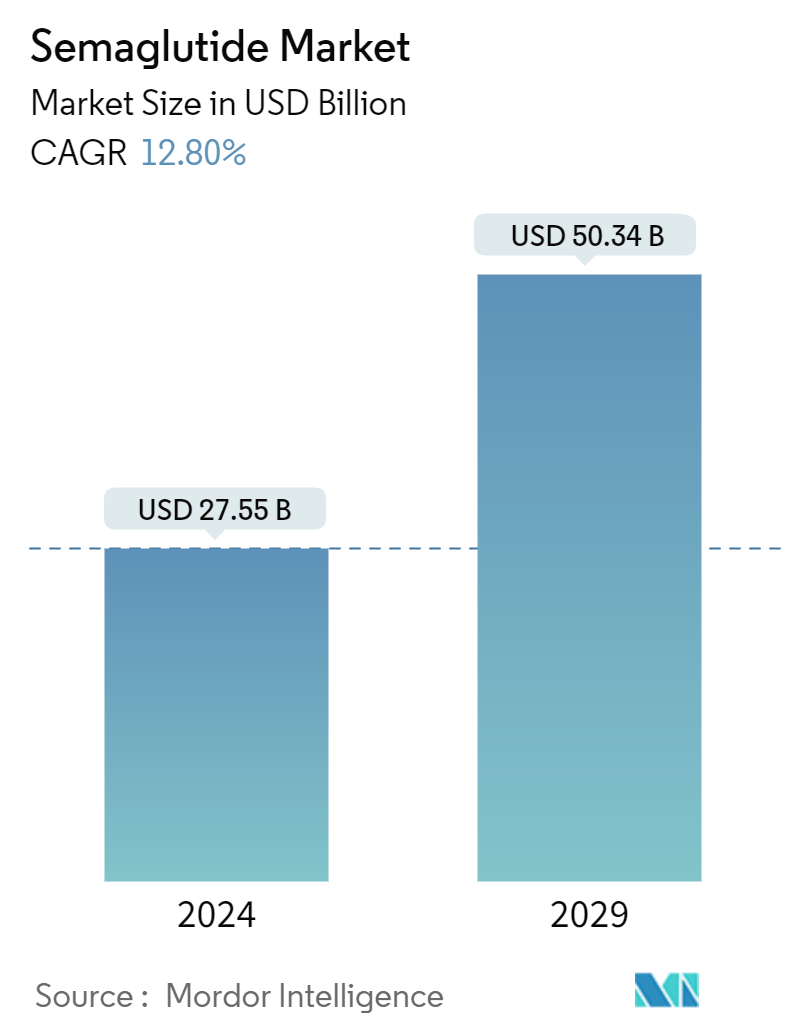
| Study Period | 2018 - 2029 |
| Market Size (2024) | USD 27.55 Billion |
| Market Size (2029) | USD 50.34 Billion |
| CAGR (2024 - 2029) | 12.80 % |
| Fastest Growing Market | Asia Pacific |
| Largest Market | North America |
Major Players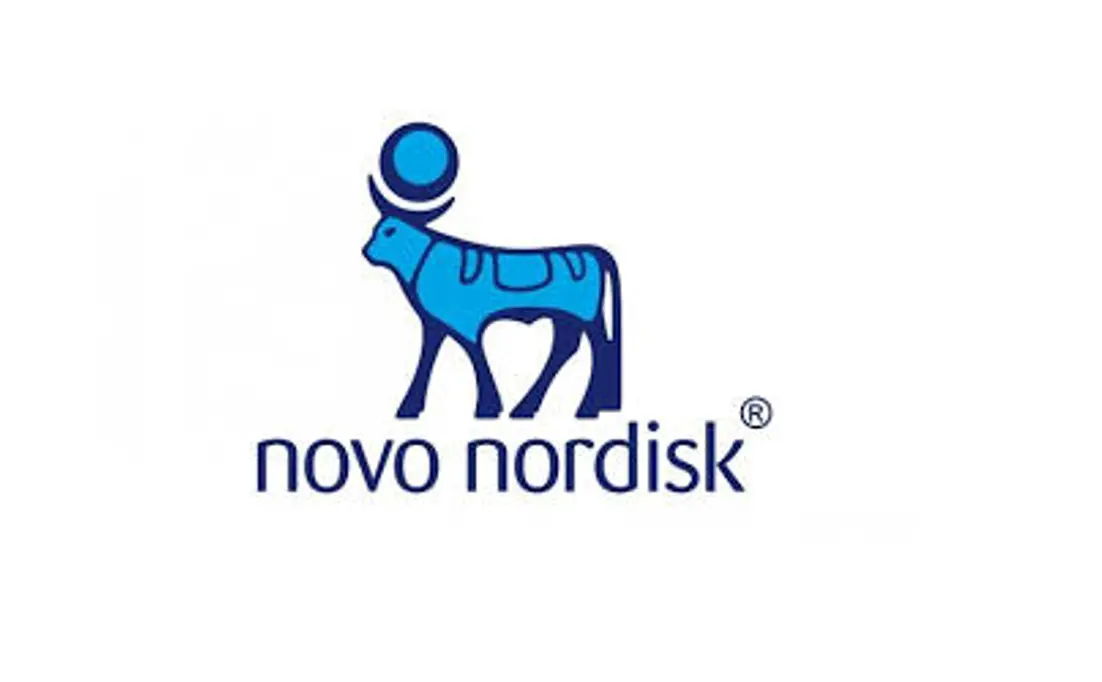
*Disclaimer: Major Players sorted in no particular order |
Semaglutide Market Analysis
The Semaglutide Market size is estimated at USD 27.55 billion in 2024, and is expected to reach USD 50.34 billion by 2029, growing at a CAGR of 12.80% during the forecast period (2024-2029).
Obesity is a significant public health concern worldwide, leading to various diseases like stroke, heart disease, cancer, and type 2 diabetes, which are among the significant causes of mortality. Glucagon-like peptide-1 receptor agonists have been identified as a promising option for treating obesity. Currently, five drugs for long-term use for obesity, including orlistat, phentermine-topiramate, naltrexone-bupropion, liraglutide, and semaglutide, are approved by the Food and Drug Administration (FDA). Semaglutide 2.4 mg is administered subcutaneously once a week for adults who are overweight and have a BMI >27 kg/m2 with at least one weight-associated condition (such as high blood pressure, type 2 diabetes, or high cholesterol) or adults with a BMI of 30 kg/m2 or greater.
Semaglutide is used to regulate blood sugar levels in adults with type 2 diabetes, along with exercise and diet, when other medications do not control the sugar levels. In addition, semaglutide reduces the risk of various diseases, such as heart attack and stroke, among adults who have type 2 diabetes. However, the drug is not used in the treatment of type 1 diabetes, which is a severe disease that may develop if high blood sugar is not treated. Semaglutide falls under the incretin mimetics drug class, which functions by helping the pancreas release insulin when blood sugar levels are high. Additionally, the drug slows down food movement through the stomach and may reduce appetite, thus helping with weight loss.
The World Health Assembly Resolution 2022 recommended the integration of treatment and prevention of diabetes into primary health services, the development of pathways for a substantial increase in insulin access, the focus on harmonization and convergence of regulatory requirements for diabetes medicines and technologies, and improved diabetes monitoring and surveillance. It involves the WHO in advising the Member States to ensure the uninterrupted treatment of people living with diabetes in humanitarian emergencies. This critical milestone provides a global mandate for diabetes efforts for the next decade.
Major factors that are expected to boost the market’s growth during the forecast period are rising obesity and inactivity rates among people, which have resulted in an increase in the diabetes population over time, a rise in the sedentary lifestyle, improper dietary patterns, and the inherent history of diabetes disorders. In addition, rising investment in R&D, technological developments, and new product launches may provide potential opportunities for glucagon-like peptide 1 (GLP-1) agonists, such as semaglutide, in the coming years.
Semaglutide Market Trends
Wegovy is Expected to Register Significant Growth Over the Forecast Period
Wegovy is primarily used with a personalized low-fat, low-calorie diet and exercise to aid weight loss in overweight adults with diabetes, high blood pressure, or high cholesterol. Additionally, the drug aids in weight loss among overweight children 12 years of age or older.
In November 2023, Novo Nordisk announced plans to spend USD 6 billion to boost manufacturing capacity to cater to the booming demand for Ozempic and Wegovy, which are weight loss and diabetes drugs, respectively. The company briefed that it would invest in increasing production capacity in Kalundborg, Denmark, within its chronic diseases portfolio. The company also stated that it will increase its funds to boost its capacity to manufacture active pharmaceutical ingredients while boosting other parts of its supply chain, such as packaging.
The significant factors driving the segment’s growth include a surge in obesity among people and an increasing prevalence rate of heart disease and type 2 diabetes. People suffering from high-fat content are more likely to be affected by diabetes in the future. For instance, according to the UN estimates published in March 2022, more than one billion people worldwide were obese, including 39 million children, 340 million adolescents, and 650 million adults, and the numbers are likely to rise. The World Health Organization predicted that by 2025, roughly 167 million people are likely to become overweight or obese. As per the World Obesity Atlas 2023, the forecasts for global obesity and overweight (BMI ≥25kg/m²) suggest that over 4 billion people may be affected by 2035. The prevalence of obesity with a BMI of more than 30kg/m² alone is anticipated to spread to around 24% of the population, affecting approximately 2 billion children, adolescents, and adults by 2035.
Hence, the rising burden of obesity, the increasing prevalence of diabetes, and rising investments by key players in expansion are expected to fuel market growth over the forecast period.
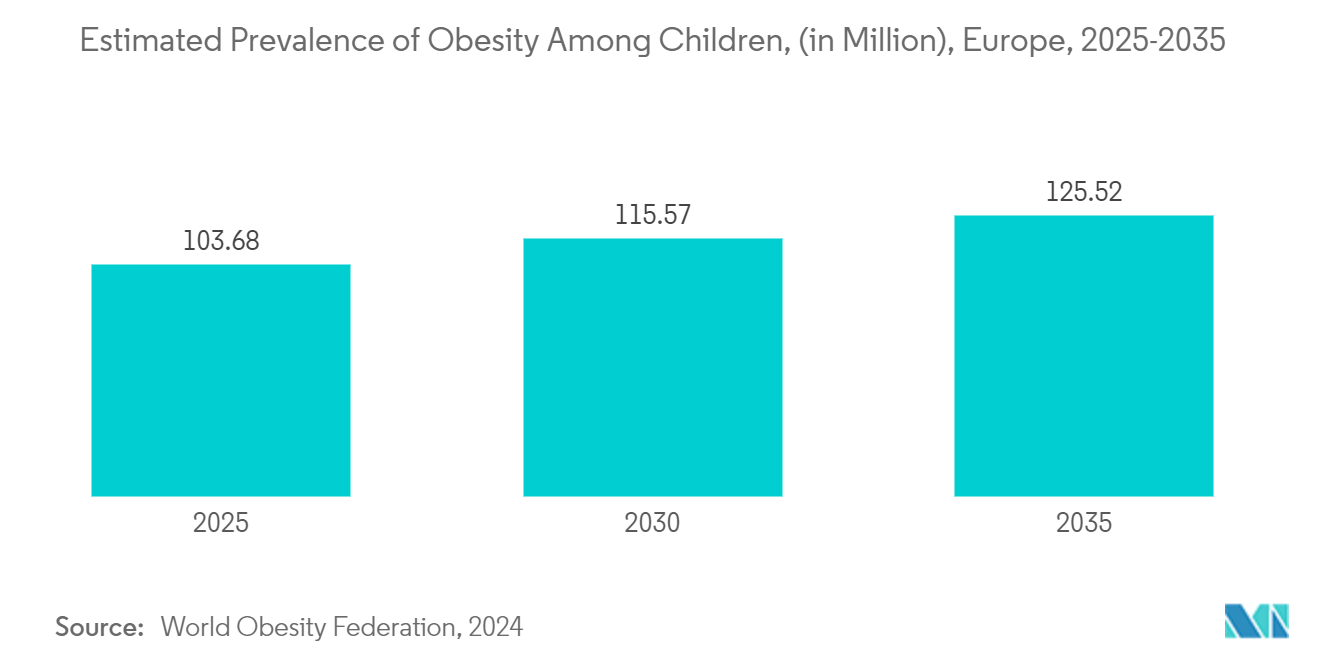
North America is Expected to Hold a Significant Share in the Market
In North America, the prevalence of diabetes has increased significantly during the last two decades, owing to lifestyle changes and a surge in obesity, coupled with physical inactivity and bad eating habits. For instance, as per the data published by the CDC in November 2023, more than 1 in 3 Americans are at increased risk for type 2 diabetes. Furthermore, more than 1 in 3 adults, i.e., about 98 million Americans, have prediabetes, and 81% of them are unaware of the condition. Similarly, in October 2022, the Government of Canada estimated that over 3 million Canadians, or 8.9% of the population, were diagnosed with diabetes. As per the same source, the prevalence of diabetes in Canada has been rising at an average rate of 3.3% per year. In addition, 6.1% of Canadian adults have prediabetes, making them highly prone to the development of type 2 diabetes.
The American Diabetes Association (ADA), the Endocrine Society, the American College of Physicians, the American Academy of Paediatrics, the Society of General Internal Medicine, and the National Academy of Medicine published statements and issued calls to action to address social determinants of health at the individual, organizational, and policy levels. The ADA also published a scientific review describing the associations between SDOH and diabetes risk and outcomes, focusing on socioeconomic status, health literacy, the food environment, food insecurity, and neighborhood and physical environments, among other topics. The CDC National Diabetes Statistics Report 2022 estimated that, in the United States, more than 130 million people are living with diabetes or prediabetes.
Therefore, the studied market is anticipated to hold a significant share due to rising prevalence and other factors mentioned above.
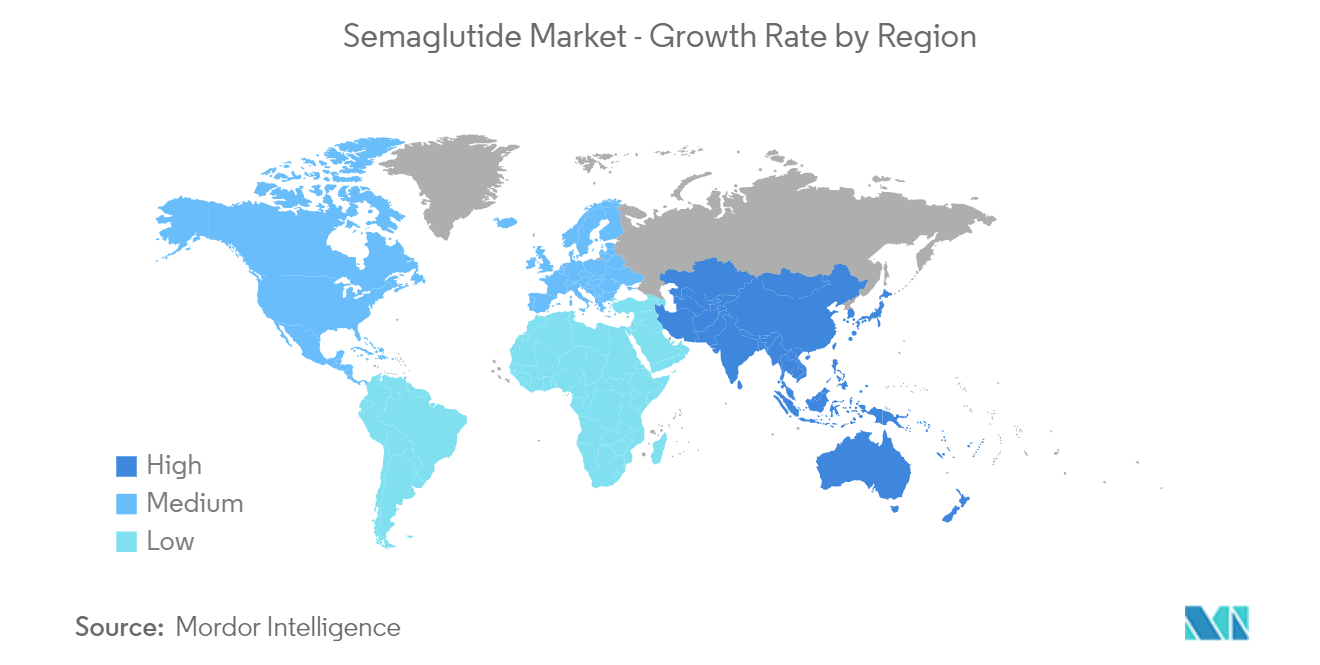
Semaglutide Industry Overview
The semaglutide market is consolidated in nature with no generic products. Novo Nordisk AS is the only player in the market.
Semaglutide Market Leaders
-
Novo Nordisk A/S
*Disclaimer: Major Players sorted in no particular order
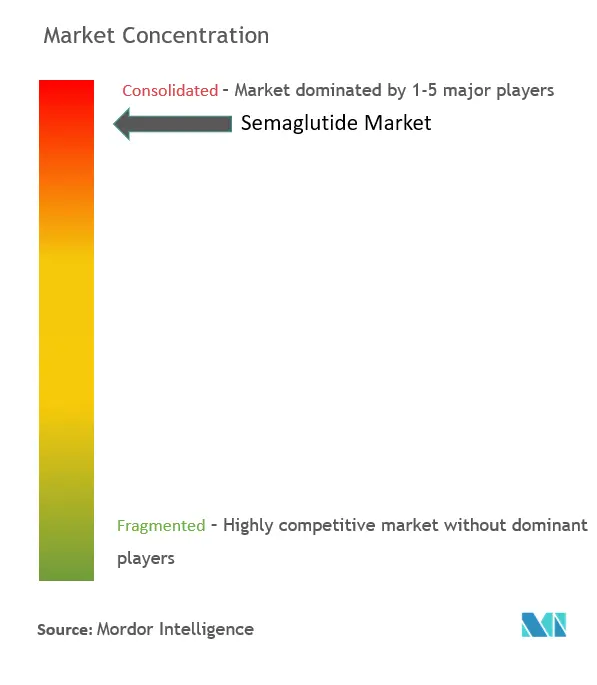
Semaglutide Market News
- November 2023: Novo Nordisk announced that Wegovy was shown to reduce the risk in people with cardiovascular disease or another cardiovascular event by 20%. The results were confirmed in a presentation of the entire dataset at the American Heart Association conference in Philadelphia.
- September 2023: Novo Nordisk advised the Ozempic Medicine Shortage Action Group and Therapeutic Goods Administration that the supply of weight loss drugs throughout FY 2023 and FY 2024 will be limited. The company stated that the demand for this drug has surged in recent months, particularly for the low-dose (0.25/0.5 mg) version, and additional demand is created by a rapid increase in prescription for ‘off-label’ use.
Semaglutide Market Report - Table of Contents
1. INTRODUCTION
- 1.1 Study Assumptions and Market Definition
- 1.2 Scope of the Study
2. RESEARCH METHODOLOGY
3. EXECUTIVE SUMMARY
4. MARKET DYNAMICS
- 4.1 Market Overview
- 4.2 Market Drivers
- 4.3 Market Restraints
-
4.4 Porter's Five Forces Analysis
- 4.4.1 Threat of New Entrants
- 4.4.2 Bargaining Power of Buyers/Consumers
- 4.4.3 Bargaining Power of Suppliers
- 4.4.4 Threat of Substitute Products
- 4.4.5 Intensity of Competitive Rivalry
5. MARKET SEGMENTATION (Market Size by Value - USD)
-
5.1 By Brand
- 5.1.1 Wegovy
- 5.1.2 Rybelsus
- 5.1.3 Ozempic
-
5.2 By Geography
- 5.2.1 North America
- 5.2.1.1 United States
- 5.2.1.2 Canada
- 5.2.1.3 Rest of North America
- 5.2.2 Europe
- 5.2.2.1 Germany
- 5.2.2.2 Spain
- 5.2.2.3 Italy
- 5.2.2.4 France
- 5.2.2.5 United Kingdom
- 5.2.2.6 Switzerland
- 5.2.2.7 Rest of Europe
- 5.2.3 Asia-Pacific
- 5.2.3.1 Japan
- 5.2.3.2 India
- 5.2.3.3 Rest of Asia-Pacific
- 5.2.4 Rest of the World
6. MARKET INDICATORS
- 6.1 Type 1 Diabetes Population
- 6.2 Type 2 Diabetes Population
7. COMPETITIVE LANDSCAPE
- 7.1 Novo Nordisk AS
8. MARKET OPPORTUNITIES AND FUTURE TRENDS
** Subject To AvailablitySemaglutide Industry Segmentation
Semaglutide is an antidiabetic medication used for the treatment of type 2 diabetes and an anti-obesity medication used for long-term weight management. The semaglutide market is segmented by brands and geography. By brands, the market is segmented into Ozempic, Wegovy, and Rybelsus. The report also covers the market sizes and forecast for the semaglutide market in major countries across different regions. For each segment, the market size is provided in terms of value (USD) and volume (units).
| By Brand | Wegovy | |
| Rybelsus | ||
| Ozempic | ||
| By Geography | North America | United States |
| Canada | ||
| Rest of North America | ||
| By Geography | Europe | Germany |
| Spain | ||
| Italy | ||
| France | ||
| United Kingdom | ||
| Switzerland | ||
| Rest of Europe | ||
| By Geography | Asia-Pacific | Japan |
| India | ||
| Rest of Asia-Pacific | ||
| By Geography | Rest of the World |
Semaglutide Market Research FAQs
How big is the Semaglutide Market?
The Semaglutide Market size is expected to reach USD 27.55 billion in 2024 and grow at a CAGR of 12.80% to reach USD 50.34 billion by 2029.
What is the current Semaglutide Market size?
In 2024, the Semaglutide Market size is expected to reach USD 27.55 billion.
Who are the key players in Semaglutide Market?
Novo Nordisk A/S are the major companies operating in the Semaglutide Market.
Which is the fastest growing region in Semaglutide Market?
Asia Pacific is estimated to grow at the highest CAGR over the forecast period (2023-2029).
Which region has the biggest share in Semaglutide Market?
In 2023, the North America accounts for the largest market share in Semaglutide Market.
What years does this Semaglutide Market cover, and what was the market size in 2023?
In 2023, the Semaglutide Market size was estimated at USD 24.02 billion. The report covers the Semaglutide Market historical market size for years: 2018, 2019, 2020, 2021, 2022 and 2023. The report also forecasts the Semaglutide Market size for years: 2024, 2025, 2026, 2027, 2028 and 2029.
Semaglutide Industry Report
Statistics for the 2024 Semaglutide market share, size and revenue growth rate, created by Mordor Intelligence™ Industry Reports. Semaglutide analysis includes a market forecast outlook to for 2024 to 2029 and historical overview. Get a sample of this industry analysis as a free report PDF download.



